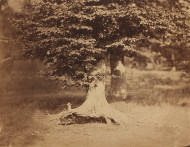
|
Gustave Le Gray (artist) French, 1820 - 1884 Beech Tree, Forest of Fontainebleau, c. 1856 albumen print from collodion negative sheet: 31.8 x 41.4 cm (12 1/2 x 16 5/16 in.) mat: 55.9 x 71.1 cm (22 x 28 in.) Patrons' Permanent Fund 1995.36.93 Not on View |
After viewing the brilliant plates made by Louis-Jacques-Mandé Daguerre, Paul Delaroche, the history painter and esteemed professor of the École des Beaux-Arts, is said to have exclaimed, "From today painting is dead."1 It was not long, however, before Delaroche realized photography's potential as both a means of artistic expression and as an aide-mémoire to artists: painters, for instance, could make quick, otherwise unattainable studies using the process.
One of the aspiring painters studying in Delaroche's studio who turned to photography was Gustave Le Gray. He began to experiment with the daguerreotype process in 1847 with François Arago, the director of the Paris observatory who had announced Daguerre's method to the Académie des sciences. In 1850, Le Gray published a treatise on his use of various photographic techniques:
Over the course of several years, I have been led to make larger applications of photographic processes to reproduce nature scrupulously in all of its aspects....I have realized the immense importance of these processes for art and the need for a method that is reliable without restriction in order to facilitate its use for artist and amateur.2
The method he developed, the waxed-paper process, was ideal for plein-air work. Because the paper negative was saturated with beeswax and immersed in chemicals, negatives could be sensitized long before they were exposed in the camera. The waxed-paper negatives, with their increased translucency, also allowed for finer detail.
Le Gray advocated an appreciation of the intrinsic beauty of the photographic process, and warned against retouching:
These gentlemen are asking from a retouched paper print what they ought to have obtained by chemical means. The detail that they add thus becomes shrill and offensive as an artistic thing....The most ordinary unretouched photographic print has a much superior artistic value than a print that has been retouched, even with the greatest care.3
Le Gray also investigated the collodion process, in which glass plates were coated with a thin film of collodion (guncotton dissolved in ether and alcohol) and sensitized with silver salts. Although collodion negatives allowed for even finer detail than the waxed-paper process, the collodion image required, as he wrote in 1852, "more depth and strength in its all-over effect."4
Le Gray's examinations extended beyond his materials to his subject matter, which he approached in a highly original manner:
The artistic beauty of a photographic print consists nearly always in the sacrifice of certain details; by varying the focus, the exposure time, the artist can make the most of one part or sacrifice another to produce powerful effects of light and shadow, or he can work for extreme softness or suavity, copying the same model or site, depending on how he feels.5
This ability to orchestrate light and shadow is clearly evident in the studies he made in the Forest of Fontainebleau, including Beech Tree, Forest of Fontainebleau, the boldly direct composition of a single, grand, eternal tree whose wounded root only adds to the heroism of the image.
Le Gray was an enormously influential photography teacher whose students became some of the most important photographers of the day, including Maxime Du Camp, Henri Le Secq, and (through Le Secq) Charles Nègre. Le Gray was a founding member of the Société héliographique and of the Société française de photographie, and he exhibited internationally in the 1850s. Despite his successes, he was continually in financial difficulties, and in 1860, Le Gray dissolved his studio, abandoned his wife and children, and fled France. Several years later he resurfaced in Cairo, where he taught drawing and painting until his death.
The rareness of photographs by Le Gray implies that he had a difficult time finding an audience. Though he sold few prints, he created, in his short career, an enduring legacy as a technical innovator, teacher, and author.
(Text by Julia Thompson, published in the National Gallery of Art exhibition catalogue, Art for the Nation, 2000)
Notes
1. Delaroche saw the plates in 1838; the process was announced to the public in January 1839. The source of Delaroche's pronouncement has yet to be located; Beaumont Newhall and Robert Doty, "The Value of Photography to the Arts, 1839," Image 11 (1962), 25, trace it to Gaston Tissandier, Merveilles de la photographie (Paris, 1874).
2. Traité pratique de photographie sur papier et sur verre (Paris, 1850). Reprinted in Eugenia Parry Janis, The Photography of Gustave Le Gray (Chicago, 1987), 29.
3. André Jammes and Eugenia Parry Janis, The Art of French Calotype (Princeton, 1983), 200–201.
4. Letter to Ernest Lacan, 1852. Reprinted in Jammes and Janis 1983, 201.
5. Jammes and Janis 1983, 202.

